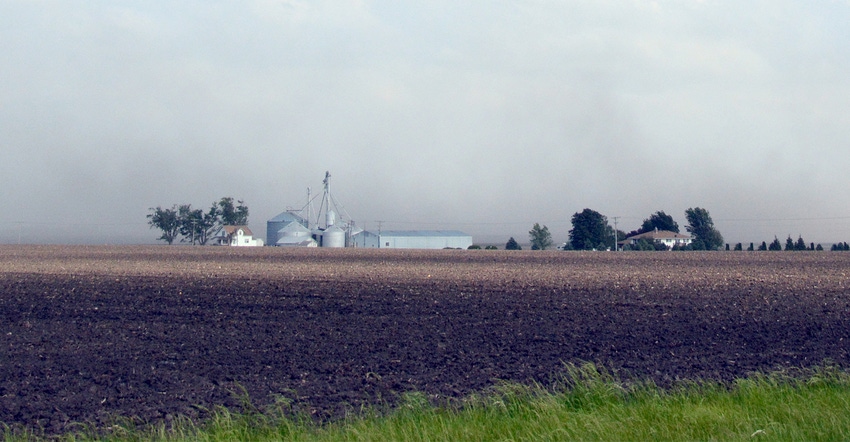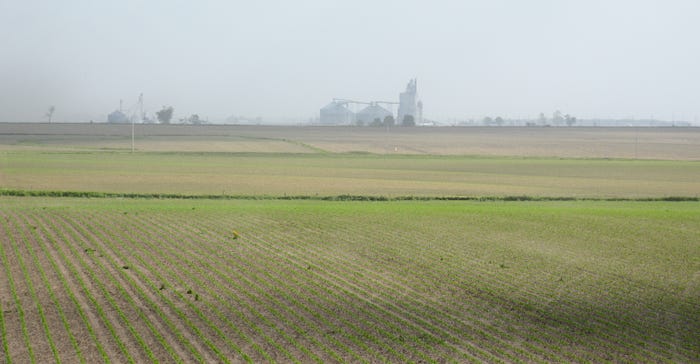August 23, 2017

If ever there were a good conversation starter in farm country, it’s the weather.
Too hot. Too cold. Too wet. Too dry. That one hailstorm. That one windstorm. That winter we had all the polar vortices.
The drought. The flood. That crazy dust storm last spring.
Weather is the great uniter, if only for complaints. Check it out next time we have a weather extreme: The local news will interview a withered grandpa in bib overalls who will proclaim he’s “never seen it this bad before.”
I felt a little that way when the dust storm rolled across central Illinois last spring. I’ve never seen anything like that. As I drove across McDonough County, dust hung high in the air. Eerie. At that moment, the soil was vulnerable, most having been worked but either not yet planted or just planted — either way, with virtually no cover. It was dry. The wind blew relentlessly that day, clocking 45 mph, and soil lifted into the air, hovering in blue skies. Priceless soil, the kind University of Illinois President Andrew Draper spoke of, engraved upon university buildings. “The wealth of Illinois is in her soil and her strength lies in its intelligent development.”
My teeth gritted the soil in the air, and I thought of everything I’ve ever read about the Dust Bowl — of people who endured it for years, and here I thought I might not make it from my car to the door of the Walmart.
Julie Wubben captured this video of dust storm in Chestnut, Illinois. #ilwx #cILwx pic.twitter.com/XU6D0e248L
— JC Fultz (@jcfultz) May 17, 2017
Weather extremes come and go, but true disasters — like our dust storm, which impaired visibility and caused actual loss of life on highways — stick with us. That dust storm was a combination of particular events that might never occur in tandem again: hundreds of thousands of acres of exposed soil, dry conditions, bad timing, 40 to 50 mph winds.
Then again, they might; many crises are combinations of particular events.
T by 2000 … or 2017?
So the recurring thought, post-dust storm: Can we eliminate any one of those particular events from the equation?
Can we eliminate wind? Probably not. Can we eliminate dry conditions? Not yet. Can we eliminate so very many acres that lay exposed? Very possibly.
Certainly, Illinois farmers are doing more tillage than we used to. After a push through the ’80s and ’90s to reduce tillage and hit tolerable soil loss levels (remember “T by 2000?”), Elliot Lagacy at the Illinois Department of Agriculture says less than 80% of the state is below tolerable soil loss.
What does tolerable mean, anyway? Lagacy, an ag land and water resource specialist at IDOA, says certain soil types can replenish themselves at a certain rate. For example, take a black prairie soil; if you lose 5 tons of that soil per acre per year, it will replenish at the same rate, and that’s a tolerable soil loss. But if you have a lighter soil where 5 tons a year is lost when it only replenishes at a rate of 3 tons per year, that’s a net loss — and below tolerable soil loss levels.
Lagacy says 1997 was the high-water mark, when 87% of the state made it to “T.”
Why are Illinois farmers doing more tillage? In a word, weeds. Low commodity prices don’t help either. “A lot of people are pushing the envelope and trying to get the crop in as soon as possible,” Lagacy says. “They want to warm up the ground quicker.”
No-till and strip till are on a downward trend, as vertical tillage trends up.
“We always stress: Do as little tillage as possible. But there’s nothing to hold anybody to that,” Lagacy says.
 STORMY: These photos don’t do the dust storm justice, but I’ve rarely seen any that do. And while it doesn’t show up in the photo, you could see different colored dust in the air: darker from darker soils in one place, lighter from lighter soils in another.
STORMY: These photos don’t do the dust storm justice, but I’ve rarely seen any that do. And while it doesn’t show up in the photo, you could see different colored dust in the air: darker from darker soils in one place, lighter from lighter soils in another.

History holds that the conditions that created the 1930s Dust Bowl were stirred by a lot of plows and a lot of folks planting wheat where grass and pasture had thrived for centuries.
As Andrew Draper observed, Illinois soils were made to grow crops. Her wealth is in her soils, and in its intelligent development. What can you do to develop them intelligently?
Comments? Email [email protected].
You May Also Like




